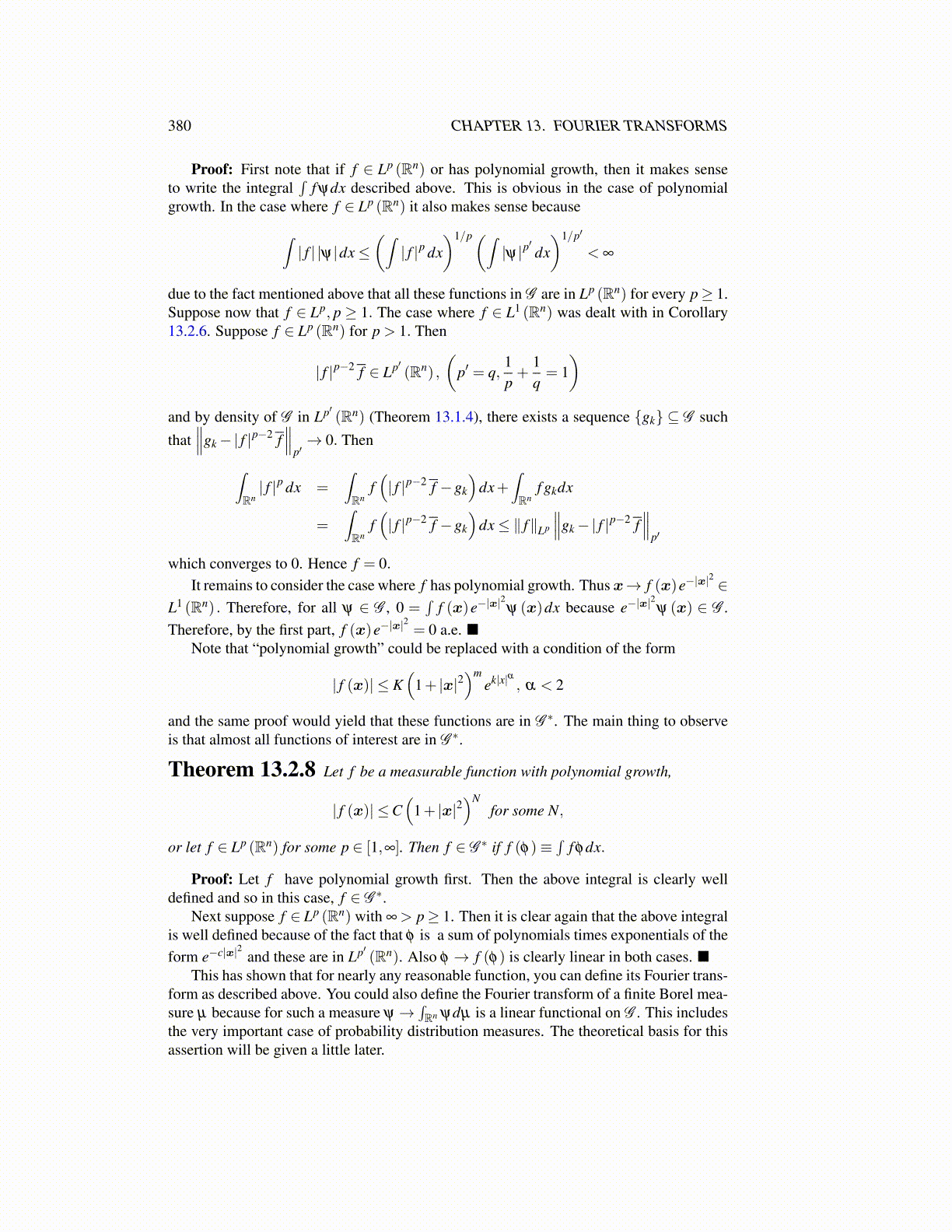
380 CHAPTER 13. FOURIER TRANSFORMS
Proof: First note that if f ∈ Lp (Rn) or has polynomial growth, then it makes senseto write the integral
∫f ψdx described above. This is obvious in the case of polynomial
growth. In the case where f ∈ Lp (Rn) it also makes sense because
∫| f | |ψ|dx≤
(∫| f |p dx
)1/p(∫|ψ|p
′dx)1/p′
< ∞
due to the fact mentioned above that all these functions in G are in Lp (Rn) for every p≥ 1.Suppose now that f ∈ Lp, p ≥ 1. The case where f ∈ L1 (Rn) was dealt with in Corollary13.2.6. Suppose f ∈ Lp (Rn) for p > 1. Then
| f |p−2 f ∈ Lp′ (Rn) ,
(p′ = q,
1p+
1q= 1)
and by density of G in Lp′ (Rn) (Theorem 13.1.4), there exists a sequence {gk} ⊆ G suchthat
∥∥∥gk−| f |p−2 f∥∥∥
p′→ 0. Then
∫Rn| f |p dx =
∫Rn
f(| f |p−2 f −gk
)dx+
∫Rn
f gkdx
=∫Rn
f(| f |p−2 f −gk
)dx≤ ∥ f∥Lp
∥∥∥gk−| f |p−2 f∥∥∥
p′
which converges to 0. Hence f = 0.It remains to consider the case where f has polynomial growth. Thusx→ f (x)e−|x|
2∈
L1 (Rn) . Therefore, for all ψ ∈ G , 0 =∫
f (x)e−|x|2ψ (x)dx because e−|x|
2ψ (x) ∈ G .
Therefore, by the first part, f (x)e−|x|2= 0 a.e. ■
Note that “polynomial growth” could be replaced with a condition of the form
| f (x)| ≤ K(
1+ |x|2)m
ek|x|α , α < 2
and the same proof would yield that these functions are in G ∗. The main thing to observeis that almost all functions of interest are in G ∗.
Theorem 13.2.8 Let f be a measurable function with polynomial growth,
| f (x)| ≤C(
1+ |x|2)N
for some N,
or let f ∈ Lp (Rn) for some p ∈ [1,∞]. Then f ∈ G ∗ if f (φ)≡∫
f φdx.
Proof: Let f have polynomial growth first. Then the above integral is clearly welldefined and so in this case, f ∈ G ∗.
Next suppose f ∈ Lp (Rn) with ∞ > p≥ 1. Then it is clear again that the above integralis well defined because of the fact that φ is a sum of polynomials times exponentials of theform e−c|x|2 and these are in Lp′ (Rn). Also φ → f (φ) is clearly linear in both cases. ■
This has shown that for nearly any reasonable function, you can define its Fourier trans-form as described above. You could also define the Fourier transform of a finite Borel mea-sure µ because for such a measure ψ→
∫Rn ψdµ is a linear functional on G . This includes
the very important case of probability distribution measures. The theoretical basis for thisassertion will be given a little later.